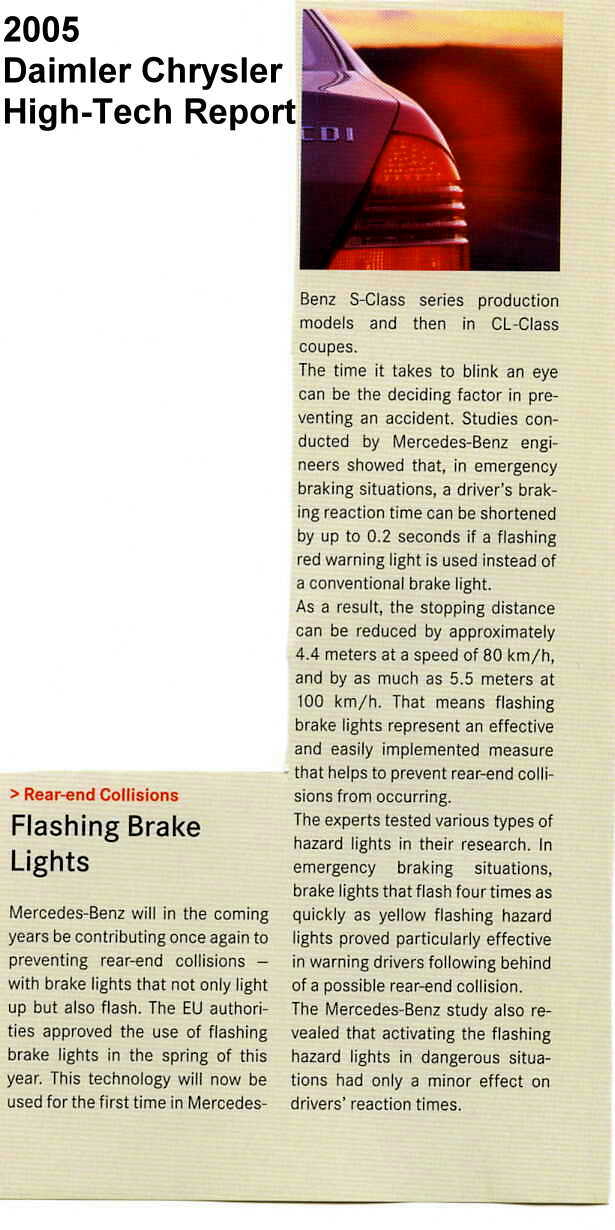| Home |

|
Email: superlumination@cox.net |
 |
|
|
MENU HERE
Click on Image for larger View
2005
Mercedes-Benz to adopt flashing brake lights
Stut
Research by Mercedes engineers showed that driver reaction times are shortened by up to 0.2 seconds if a flashing red warning signal is used, instead of a conventional brake light during emergency braking. At 80 km/hr this reduced the stopping distance by approximately 4.4 metres, and at 100 km/hr by no less than 5.5 metres.
Mercedes-Benz tested various warning light systems and found that brake lights which light up four times as quickly as amber hazard warning flashers proved particularly effective in alerting drivers behind them. The study also revealed that switching on the hazard warning system in a dangerous situation has no significant effect on the reaction times of other drivers.
Adaptive brake light: Effective warning to prevent rear-end collisions
·
Standard equipment in the new Mercedes-Benz S-Class
·
Braking distance shortened by more than four metres at 80 km/h
In their efforts to reduce the large number of dangerous rear-end collisions, Mercedes engineers have supplemented Brake Assist PLUS with a new development which warns drivers of this risk more effectively than before: flashing brake lights.
Research by Mercedes engineers has shown that driver reaction times are shortened by up to 0.2 seconds if a flashing red warning signal is given instead of the conventional brake light during emergency braking. At a speed of 80 km/h this reduces the stopping distance by about 4.40 metres, and at 100 km/h by no less than 5.50 metres or so. This means that flashing brake lights are an effective and easily implemented way to reduce rear-end collisions. It also makes motoring safer for road users who do not drive a Mercedes-Benz.
Specialists at Mercedes tested various warning light systems during their study. Brake lights which flash four times as quickly as the amber hazard warning lights during emergency braking proved particularly effective in alerting following drivers to the danger of a rear-end collision. The Mercedes study also revealed that switching on the hazard warning system in a dangerous situation has no significant effect on the reaction times of other drivers.
In future Mercedes-Benz will make a further contribution towards a reduction in rear-end collisions by means of flashing brake lights. The EU licensing authority has recently approved this technology, and it will now enter series production in the S-Class for the first time.
Research by Mercedes engineers has shown that driver reaction times are shortened by up to 0.2 seconds if a flashing red warning signal is given instead of the conventional brake light during emergency braking. At a speed of 80 km/h this reduces the stopping distance by approx. 4.40 metres, and at 100 km/h by no less than 5.50 metres or so. This means that flashing brake lights are an effective and easily implemented way to reduce rear-end collisions. The Mercedes-Benz S Class is now the first car to feature this innovative, adaptive brake light. It will shortly be followed by the CL-Class Coupés.
Specialists at Mercedes tested various warning light systems
Specialists at Mercedes tested various warning light systems during their study. Brake lights which light up four times as quickly as the amber hazard warning flashers during emergency braking proved particularly effective in alerting following drivers to the danger of a rear-end collision. The Mercedes study also revealed that switching on the hazard warning system in a dangerous situation has no significant effect on the reaction times of other drivers.
UPIC Shipping Insurance
Note: Our packages are not automatically insured against loss during shipping. Insurance is the responsibility of the purchaser!
$2.00 for each $100 unit of insurance
Shipping Insurance
$2.00 per $100



